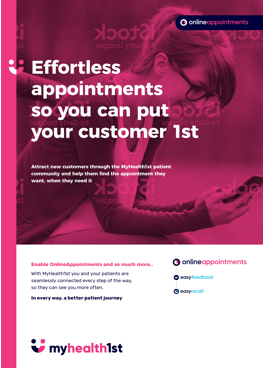
As the world steadily becomes more and more connected, having an effective social media strategy can help your practice reach and connect with patients that you may not have access to otherwise.
Simply having a Facebook page or twitter account is only the beginning of social media engagement and marketing. Having a page that is infrequently updated or contains no real content aside from contact details and location can be worse than having no online presence at all.
Having a well trafficked Facebook page with ample content, good images and lots of likes is a good way to stay connected with your patients and build loyalty, but by itself a Facebook page doesn’t do a lot when it comes to converting likes to people in your waiting room.
That’s where Facebook advertising comes in. Being able to target ads towards a specific demographic and area can make sure your advertising is seen by the right people, making it a cost effective way to market your practice and drive new patients to the door.
Facebook contains a lot of granularity when it comes to targeting advertising and tracking results, and it can look very daunting at first glance, so we’ve compiled a list of things to consider when planning a Facebook advertising strategy.
What you are looking to do with your advertising will influence the format of the ad, its targeting and spend. If you’re looking to drive more patients to your door, you need to define who these patients are, where they are from, what demographic they fill and if you’re looking to target a specific condition or symptom. You may also need to consider how many new patients this ad is looking to generate, of how much engagement you expect, as that can influence the duration and overall cost of the campaign.
If, on the other hand you’re looking to promote community engagement, you need to make a plan on how you are going to engage. Engaging a community involves continuity, content and quality, so you need a plan for who is going to be posting, how often they will post and what type of content will you be pushing on your Facebook page.
Target Your Ads, But Don’t Target Too Narrowly
Facebook allows for a great deal of granularity when it comes to targeting your advertising, allowing you to narrow your target audience by gender, age, location and interests. Trying to narrow your focus to an incredibly tight group may seem appealing, but in many cases, especially when advertising a practice, keeping the targeting fairly broad can be advantageous.
If you’re looking to boost the profile of a GP practice, simply targeting the advertising to within around 20 or 30kms around the practice gives you good blanket coverage of the area. This can give you good conversions, both with the local community and in terms of word of mouth.
Specialist practices can afford to be a little more specific with their targeting. A gynecologist’s office, for example, should be limiting the advertising by gender. If you’re looking to advertise a specific treatment or condition, you may wish to limit advertising to the age range in which the condition is typically first diagnosed.
The more you refine your targeting, the more expensive and difficult it can be to convert advertising into patients, as not only will you be limiting the number of people who will see your ad, you will also risk having to bid against other advertisers for the same space.
Choose Your Words Wisely
Facebook is very picky when it comes to what can be posted in an advertisement. Certain words and phrases are essentially banned outright, and others can make it difficult for an ad to be approved. AHPRA also has restrictions on what kind of language can be used in advertising for medical practices, so you have to be very careful in your choice of words when it comes to formulating ads.
- Banned Words - You cannot refer to yourself or anyone at your practice as an expert, or use terminology that cannot be immediately proven.
- Personal Attributes - Advertising text directly referencing or alluding to a personal attribute is prohibited. What this means is that you can’t write an ad that assumes something about the target of the ad. In essence you can say. Thi can be especially problematic when it comes to medical advertising as you are often trying to talk to people with specific conditions or symptoms. In essence you can’t say “Do You Suffer Migraines?” as the “you” attributes migraines to the person reading the ad, but you can say something like “Migraines Can Be Debilitating”. Reviews - AHPRA does not allow reviews to be used in advertising, but testimonials that do not directly refer to medical treatments of professionals can be used - someone saying you are the best doctor they have ever seen is a no-no, but a testimonial saying that the staff were friendly or that they enjoyed the cup of tea they were given while waiting is fine.
If you are interested in learning more about Facebook advertising restrictions, the social media giant has collated a list of the types of advertising or content that are not allowed and AHPRA has posted comprehensive Advertising Guidelines .
Facebook posts and advertisements with images generate a great deal more engagement than those without, but which image you choose could additionally help or hinder a post or ad. Images can contain text, but can be penalised for having too much text. Having too much text doesn’t simply come down to having too many words, but how much of the image contains text, so a post with two words that take up approximately 20% of the image (maximum suggested) may track worse than one with 20 words that take up 10%.
Before adding an image with text, we recommend using the Facebook Image Test Check to see if the amount of text in an image could impact the reach of your advertising.
Some images may be flagged for other reasons as well, such as sexual or violent content. Images don’t need to actually contain violent or sexual content to be flagged as containing such. Images are flagged by an algorithm, and mistakes can and will be made. While it’s easy enough to lodge a review of the ad, it can be frustrating to have to wait a few days for approval.
Some of the reasons your images may be flagged include:
- Adult Content - Although your image may not be pornographic in any way, Facebook prohibits images with excessive skin as well as those that focus on a specific body part (such as the chest, abs or rear) even if the images aren’t sexual in nature. This can make it challenging when it comes to posting content based around specific symptoms or conditions.
- Prescription Drug Treatments - Facebook prohibits any advertising related to drug use, illegal or prescription.
- Health Related Imagery - Facebook does not allow before and after images to be used in advertising. This can be especially difficult for cosmetic dentists or surgeons. In addition, Facebook bans images it sees as generating a negative self image if you’re promoting diet, weight loss or other similar problems. In essence you can post an image of someone eating something healthy and your ad will go through fine, but if you show someone standing on scales or trying to fit into too small clothes, you will have a problem.
You Get What You Pay For
As with most things, you get what you pay for with Facebook advertising. This doesn’t mean you have to spend extravagant amounts of money, but you shouldn’t be seduced by cheap advertising options either. Boosting a post or creating an ad can cost as little as $5 or $10, but for such a small fee the reach of the ad as well as its longevity is limited.
Each ad may require a different investment, depending on the goals you have set for the campaign and any competition in the same space (even if it’s not necessarily healthcare related). As a rule of thumb, starting a campaign at around $10 a day is a good first step, as you can see what comes from it and refine and build from there.
Facebook Ad Manager allows you to easily monitor your result so you can build more effective campaigns moving forward. Depending on the focus of your campaign, some tracked metrics may be more important than others, but as a general rule Frequency (how many times the ad had been displayed), Return on Ad Spend, Cost per Click, Click Through Rate and Cost per Action are the five most important metrics to monitor for your Facebook ad campaigns.
MyHealth1st has added Managed Digital Marketing to its stable of products. Our team of expert digital and social media marketers are ready to help grow your practice with creative and well targeted social media and digital advertising campaigns. To find out more about how MyHealth1st can manage your digital marketing.
